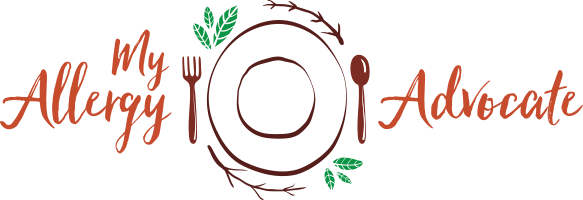Goat Dairy| Lactose Intolerance
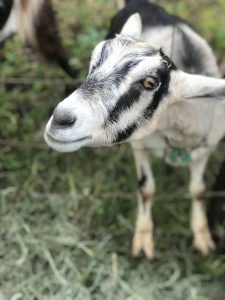
If you have a lactose intolerance and not a milk allergy, goat milk might be an alternative for you. Read more about my visit to Surfing Goat Dairy Farm on Maui. All photos taken by Imei Hsu with permission.
Transparency and Disclaimer: I visited Surfing Goat Dairy Farm in Maui in March 2018. They have not paid me to write a post about them, nor given me free product in exchange for promotion. You should check with your allergist if you have concerns about your reaction to lactose and determine if you are allergic or intolerant to lactose before eating any lactose-containing foods.
Do you have a cow’s milk allergy? The bad news is that sheep, goat, and buffalo milk are still restricted if you have an allergy to cow’s milk, due to the way the body recognizes the protein and launches an allergic reaction. If you are allergic to cow’s milk, it is not safe to drink these other milks, no matter what you read and no matter who gives you an n=1 story, unless that person has undergone a complete desensitization and successfully passed a baked milk challenge.
However, if you have a lactose intolerance, there may be some good news for you. Goat’s milk has less of the lactose protein in it, and you are likely to come across lactose intolerant people who can successfully eat foods containing goat’s milk without any of the digestive symptoms (cramping, diarrhea, gas, bloating) that accompany cow’s milk consumption.
I just happen to be one of them. For a person with so many food intolerances, a few food allergies, and multiple restrictions due to Celiac Disease, that’s pretty lucky.
So when I had the opportunity to visit Surfing Goat Dairy Farm in Maui, I jumped at the chance to go, along with a few friends. While there, I learned a few facts that might convince you to consider goat dairy, especially if cow’s milk gives you those Grumpy Tummy reactions we all want to avoid.
So, What’s Up with Goat’s Milk Anyway?
If you do a search on the Internet, you will encounter all kinds of posts about whether or not goat’s milk is safe for those who are allergic to cow’s milk or have a lactose intolerance. As mentioned above, conventional medicine is pretty clear about allergies: if you are allergic to cow’s milk, goat and sheep’s milk aren’t going to be a solution. You should check with your doctor if you are interested in a desensitization program to possibly reintroduce a known allergen into your eating regimen.* Here, I am only talking about goat’s milk for those with a lactose intolerance.
Let me say that for clarity’s sake. If you have a lactose intolerance and not an allergy to lactose, goat’s milk might be an option. And that’s might.
Goat milk has lactose in it, and that is the same protein that people are reacting to in an allergic reaction to cow’s milk. The reason some people with a lactose intolerance can consume goat milk products safely is because there is less lactose in goat’s milk than there is in cow’s milk for the same quantity. It is easier to digest, and therefore does not cause the GI distress involved — namely, gas, cramping, and nausea. Think of it as something that the lactose intolerant person might be able to get away with.
For those who have never tried goat milk products, it’s often described as more acidic, tangy, and less creamy. A cheese from goat’s milk can range from a soft, spreadable cheese, to a Gouda that can melt from shreds or shavings.
After a few years of avoiding dairy products altogether, I discovered that my suspected milk allergy was a high lactose intolerance. The testing done isn’t always accurate, and it is a good idea to be retested every so often. Since most of my family is lactose intolerant, it was still a good idea to avoid cow’s milk; at least I know that if I was accidentally exposed to cow’s milk, I wasn’t going to need to use an EpiPen.
Surfing Goat Dairy Farm
 On arrival, a light rain was falling as our car pulled into the parking lot. We drove past surf boards attached to the gates, the surf board sign, and then a pen of baby goats. What’s with the surf boards, hmm?
On arrival, a light rain was falling as our car pulled into the parking lot. We drove past surf boards attached to the gates, the surf board sign, and then a pen of baby goats. What’s with the surf boards, hmm?
One of my friends pointed out that the male baby goats were already “getting busy” with the female baby goats. No joke, the males are ready to go as early as four month’s old, though the female counterparts won’t be ready to make babies until sometime after nine months. The things you learn about goats when you visit a goat farm, oh my!
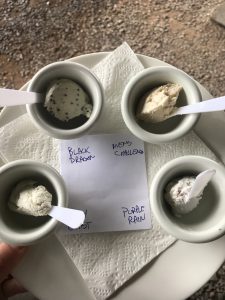
The names of the goat cheeses were delightfully clever, rich in flavor and texture, and tangy as they were creamy. Each was carefully selected for me by ingredient, to make sure they were gluten free and allergen safe.
At the ticket counter to start the tour, we were offered samples of a variety of goat cheeses from their tasting menu, and one of the counter staff helped me determine by ingredient which ones were gluten free and free of my other food allergies and intolerances. I greedily accepted a sample of four different goat cheeses.
During the tour, we got to feed the goats, walk through the farm, milk a goat, and learn more about the goat milk process from farm to table. When our tour guide told us about their six-week internships, a part of me was saying, “Sign me up!” What part of living on Maui, free room and stipend, taking care of goats, and learning an actual skill about the raising of farm animals, would I not like?
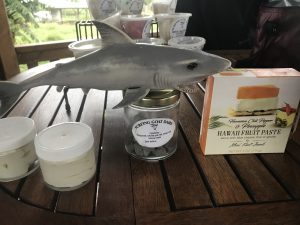
Even more goat cheese and other goat milk products await you at the end of the tour.
While we were milking the goats by hand before a helper placed pumps on the goats and finished up, I saw something move. All along, there was an old goat standing on a wooden surfboard on the other side of a low fence, watching us like a sentinel. I hadn’t really noticed him because he had been standing there so quietly, balanced up on the surfboard. Ah, perhaps he’s the reason why the farm is called Surfing Goat Dairy Farm — this goat is a surfer dude!
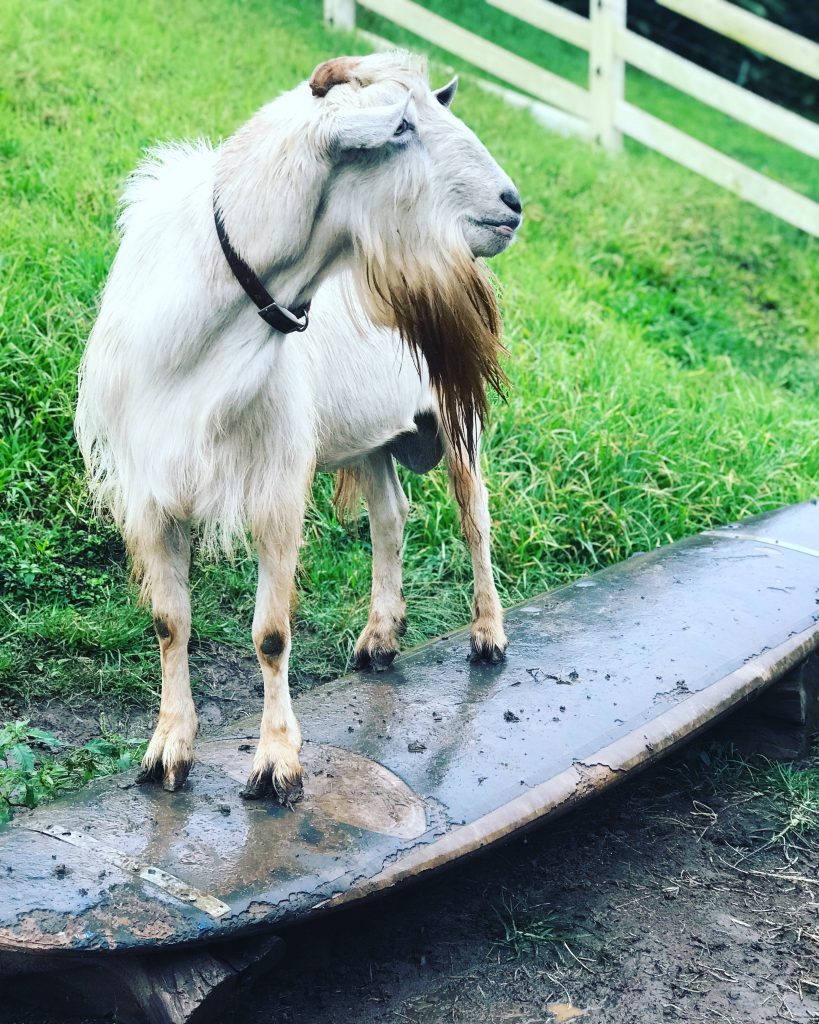
Yep, that is a real goat and not a statue! He was standing in the rain on his surfboard.
Surfing Goat cheese can be purchased directly from the farm and shipped in a special container that will survive your flight home, no worries. With some 200 goats, the number of restaurants and chain grocery stores that carry the brand is also expanding, with the majority found in the Hawaiian Islands, and the Bay area and Southern California. Purchase info can be found here.
Ways to Eat Goat Dairy
In day-to-day eating, I don’t eat much goat and sheep dairy products, except when I am in need to reduce meat consumption and increase calorie and fat consumption for my fitness training purposes. Cheeses and milks of any kind can be congestive, and athletes and casual exercisers might find that this affects their breathing and mucus production at a very low level.
When I do have a recipe that calls for something buttery or creamy, goat milk products are my go-to. A small amount of goat butter in a pan can make a sear on a fish, shellfish, or meat just as perfect as cow’s butter; an accompanying cream dill sauce made from goat yoghurt is a delight for those who have grown accustomed to passing on the standard cream-based dill sauce served with white fish.
While goat’s milk butter does not have the natural sweetness of butter from cows, I welcome it as a means of keeping my eating social and inclusive. Among my friends who can eat everything, they can readily eat my “free from” foods and substitution foods, and most won’t notice the goat milk substitution unless it is an obvious component of a stand-alone food, such as the goat yoghurt and dill sauce I mentioned.
I have many happy memories of hanging out with friends during, “Cheese and Cracker” nights. With Chez (vegan cheese) and crackers becoming a thing, why not goat cheese and gluten free and emulsifier free crackers for those for whom the vegan food options aren’t quite the right one for their dietary restrictions? Daiya’s vegan cheese shreds, for example, contain ingredients that are on my restricted list (xanthan gum and peas); Earth Balance’s vegan Coconut Spread contains sunflower seed lecithin, which until only recently, was on my no-go list, and palm oil, which is still on my no-go list of restricted oils. Tummy does not want!
For creative cooks making allergen-free foods for little ones to eat with their friends, finding the right substitute is so important in helping them feel included when socializing, playing, and learning how to safely eat around others. I respect and empathize with all you caregivers who are trying to make food day in and day out that satisfies, fuels, and delights your children.
For those who can tolerate goat dairy, I hope you’ll look into it as way to expand your eating regimen and make food fun again! Goooo-at to it!
*note: As I follow the latest news on food allergen treatments and desensitization programs, every person should understand that there are risks involved. Even when conducted in a doctor’s office, there is a small risk of anaphylaxis and death. While the future is bright for curing food allergies, the current treatment is avoidance of all food allergens that cause anaphylaxis. Desensitization is not a guarantee of cure.



